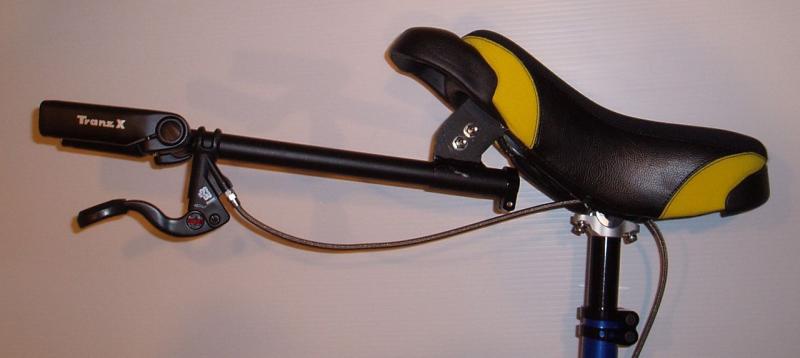Hey,
I just posted about the 2009 KH lineup here, including a description and photo of the new T-bar touring handle.
As mentioned in that thread, the objective was to make an adjustable handle that allows a moderate extended-forward riding stance, stays out of the way of your knees, and uses bar-ends that can be replaced if damaged in a crash, and is as simple as possible to install and maintain. Attached is a photo, and a schematic drawing.
So far, I believe that this style of handle, with a uni saddle, will be the most popular approach for most kinds of riding. For myself, even on long rides I find that there are a lot of times when I want to switch to an upright stance for bumps, idling, crosswinds, or just switching positions, and a combo of extended handle and a uni saddle is good for that. It is also very simple and does not introduce any additional complications such as frame sizing for different riders.
In my opinion, this configuration also (IMO) also works well for steep climbing where you are pulling up hard because you can use the existing handle with no need for additional hardware, and because if you stand up and pull on the handle, the frame will always swing forward to be directly beneath you with no additional bulk out front. For myself, I like having the frame angled back when in touring mode because there’s nothing to hit between my legs.
So far, I am not yet sure that a full, bike-like frame is needed since unlike a bike we are only supporting a handle, not a wheel, and strength seems adequate for at least the length of this production T-bar. For those of you who want to experiment with longer versions, the T-bar uses standard 22.2 mm tubing and it would be easy to make a different dimension of T-section and use all the rest of the existing hardware. A really long custom handle might require an additional reinforcement though, extending below the bar back to the frame.
Having angle adjustment and bar-ends that are adjustable also allows the handle to be clamped tight enough to stay in place, but loose enough that it can be bumped out of position in a crash, reducing the chance of breakage.
Kris
T-bar R3-Layout2_orig.pdf (159 KB)
